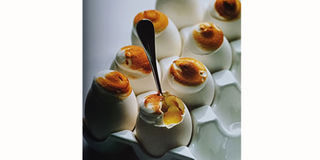Prime
What you ought to know about soufflés

In the world of eggs, the soufflé is considered the crème de la crème of the culinary world while the timbale is her even tempered relative. PHOTO/A Kadumukasa Kironde II
Eggs are amazing for their versatility and it is not surprising that so elegant an item should turn out to hold a remarkable treasure trove of balanced nutrients inter alia: fats, proteins and minerals. In Uganda, aside from the iconic Rolex, eggs and egg dishes may be acceptably served at any meal bar none. Eggs can be served fried, scrambled, boiled, poached, baked, or incorporated into omelets or into a soufflé etc. Not to mention countless variations of meat, vegetables or fish in which may or not be folded.
No egg dish succeeds unless the eggs that are used are strictly fresh which if anything is a factor in the Europe and America where eggs by law can be two months old by the time you buy them. Here in Uganda, in general the eggs one buys are relatively fresh by comparison so this would not be an issue. With all due respect when cooking eggs, the rule of thumb is to ensure that they are cooked for their delicacy and sensitive response to heat. The only time when heat should be high and brief is when preparing omelets.
Otherwise, dishes in which eggs predominate are best gently cooked and carefully timed. When combining eggs in custards, soufflés and sauces, let them partially cook on the stored heat in the pan. At all cost, do not put them back on direct heat, because they never will have so satisfactory a texture.
Maximise leftovers
In the world of eggs, the soufflé is considered the crème de la crème of the culinary world while the timbale is her even tempered relative. With closer cultivation both become quite tractable and are glamorisers for those leftover foods that in the freezer over the Christmas and New Year festivities. Cooked foods are best to use in both soufflés and timbales inasmuch as they release less moisture as opposed to raw freshly cooked food items.
Soufflés have a duration as evanescent as the ‘breath’ for which they are named; although some may last longer than others, but all of them share a common denominator of having a built in limit for holding their puff. If the soufflé is well made, then you can count on about 10 minutes in a holding oven, but be wary of drafts.
Since they depend on egg white and steam for their ascent of the whites until the soufflé is popped quickly into the preheated oven. With few exceptions, every action including immediate serving after baking should contribute the ‘breath’ as long as possible. These tours de force often based on a white sauce with egg yolks and whipped whites are easy to make providing the pointers are carefully heeded. Ideally speaking, the white sauce ought to be a rather firm one that is heated just to a boil.
Make sure you remove it from the heat for 30 seconds before the room temperature eggs and any other ingredients also at the same temperature are added. The egg white should be stiff but not dry. Incidentally, soufflés can always be made lighter if an extra egg white is added for every two whole eggs.
The process
To prepare a soufflé dish for baking, use a straight sided ovenproof baking dish. Grease the bottom and sides well with butter and coat the buttered with a thorough dusting of flour, sugar or dry grated cheese, depending on the flavour of your soufflé. It will also climb up the sides of an ungreased baker, but it will not rise so high and the lovely brown crust stick and have to be scrapped off the sides rather than forming the glossy coating that adds so much to the look of the individual serving. Next be sure that the oven is heated to the indicated temperature.
Egg soufflé
Serves 4
• 8 eggs
• The juice of 3 largish lemons
• 325g (1½ cups plus 2½ tablespoons) caster (superfine or granulated) sugar
• 40g (2 ½ tablespoons) unsalted butter
Method
1. Using an egg cutter, cut the tops of the eggs and discard the tops keeping only the bottom section of the shell for presentation purposes. Separate the yolks and whites of 4 eggs. The remaining 4 eggs can be used for an omelette the following day.
2. Make a lemon curd by placing the egg yolks, lemon juice, 100g (½ cup) of the sugar and the butter in a microwave safe bowl and microwaving them for five minutes, pulling out to whisk every minute.
Cover with cling film (plastic wrap) and leave it to cool. It will thicken as it cools. The lemon curd can be made the day before and kept in the refrigerator.
3. Whisk the egg whites, adding half the remaining sugar little by little, until they form soft peaks. Fold in the remaining sugar with a spatula.
4. Place the 8 eggshells in eggcups. Put the meringue in a piping bag and half fill each shell with meringue. Put the lemon curd in another piping bag and pipe about a teaspoonful into each eggshell. Add more meringue to the top to make it look like a soufflé.
Place in a microwave for five seconds before serving. If you have a blowtorch, you can burn the top for a few seconds, or they can be put under a hot grill (broiler) for a few seconds.
TIP
In the world of eggs, the soufflé is considered the crème de la crème of the culinary world while the timbale is her even tempered relative. With closer cultivation both become quite tractable and are glamorisers for those leftover foods that in the freezer over the Christmas and New Year festivities.




